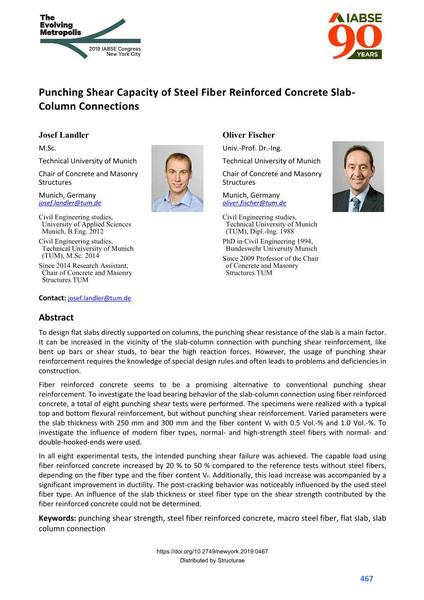Punching Shear Capacity of Steel Fiber Reinforced Concrete Slab- Column Connections

|
|
|||||||||||
Bibliografische Angaben
| Autor(en): |
Josef Landler
(Technical University of Munich, Chair of Concrete and Masonry Structures)
Oliver Fischer (Technical University of Munich, Chair of Concrete and Masonry Structures) |
||||
|---|---|---|---|---|---|
| Medium: | Tagungsbeitrag | ||||
| Sprache(n): | Englisch | ||||
| Tagung: | IABSE Congress: The Evolving Metropolis, New York, NY, USA, 4-6 September 2019 | ||||
| Veröffentlicht in: | The Evolving Metropolis | ||||
|
|||||
| Seite(n): | 467-472 | ||||
| Anzahl der Seiten (im PDF): | 6 | ||||
| DOI: | 10.2749/newyork.2019.0467 | ||||
| Abstrakt: |
To design flat slabs directly supported on columns, the punching shear resistance of the slab is a main factor. It can be increased in the vicinity of the slab-column connection with punching shear reinforcement, like bent up bars or shear studs, to bear the high reaction forces. However, the usage of punching shear reinforcement requires the knowledge of special design rules and often leads to problems and deficiencies in construction. Fiber reinforced concrete seems to be a promising alternative to conventional punching shear reinforcement. To investigate the load bearing behavior of the slab-column connection using fiber reinforced concrete, a total of eight punching shear tests were performed. The specimens were realized with a typical top and bottom flexural reinforcement, but without punching shear reinforcement. Varied parameters were the slab thickness with 250 mm and 300 mm and the fiber content Vfwith 0.5 Vol.-% and 1.0 Vol.-%. To investigate the influence of modern fiber types, normal- and high-strength steel fibers with normal- and double-hooked-ends were used. In all eight experimental tests, the intended punching shear failure was achieved. The capable load using fiber reinforced concrete increased by 20 % to 50 % compared to the reference tests without steel fibers, depending on the fiber type and the fiber content Vf. Additionally, this load increase was accompanied by a significant improvement in ductility. The post-cracking behavior was noticeably influenced by the used steel fiber type. An influence of the slab thickness or steel fiber type on the shear strength contributed by the fiber reinforced concrete could not be determined. |
||||
| Stichwörter: |
Flachdecke faserverstärkter Stahlfaserbeton
|
||||
